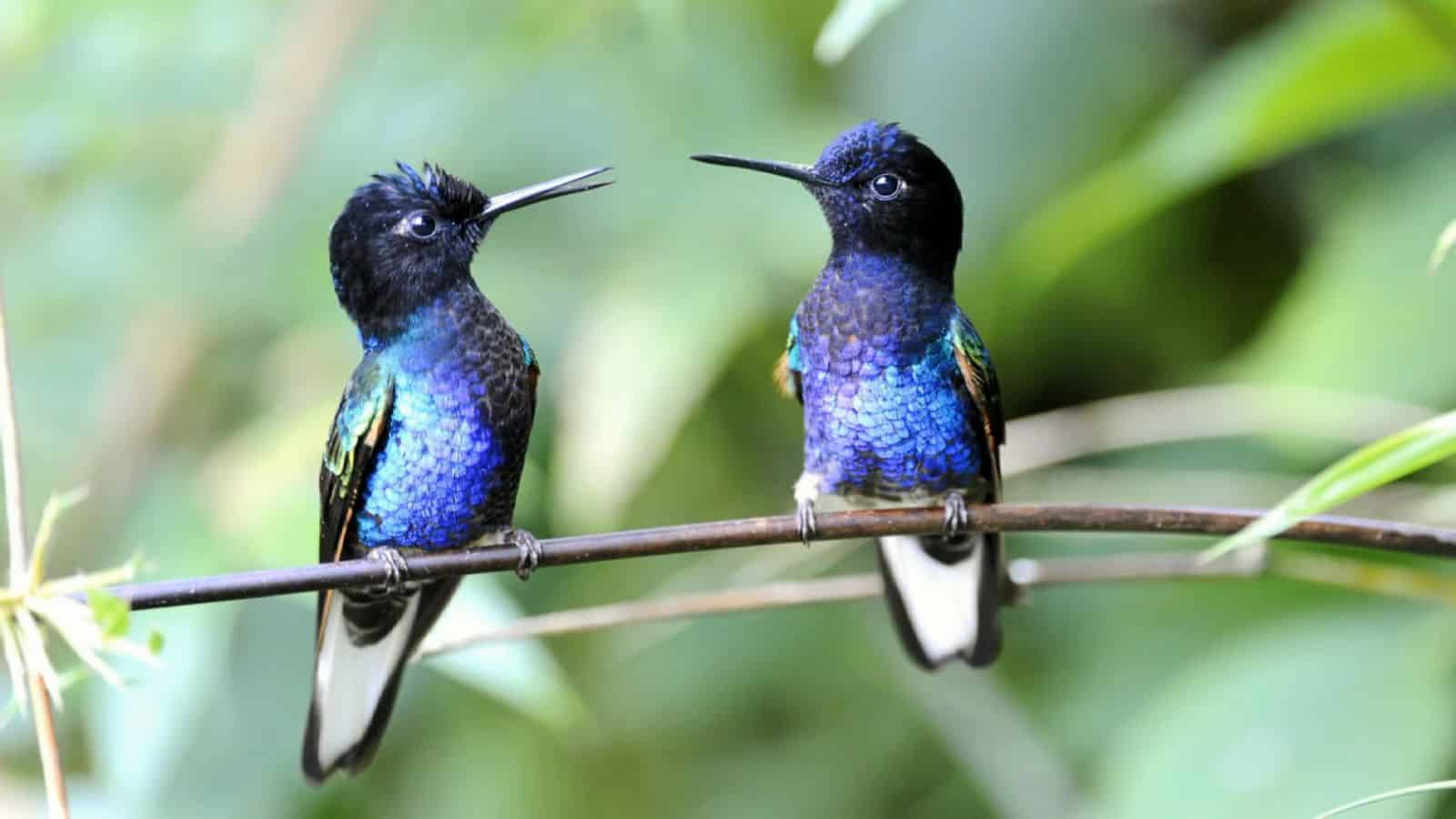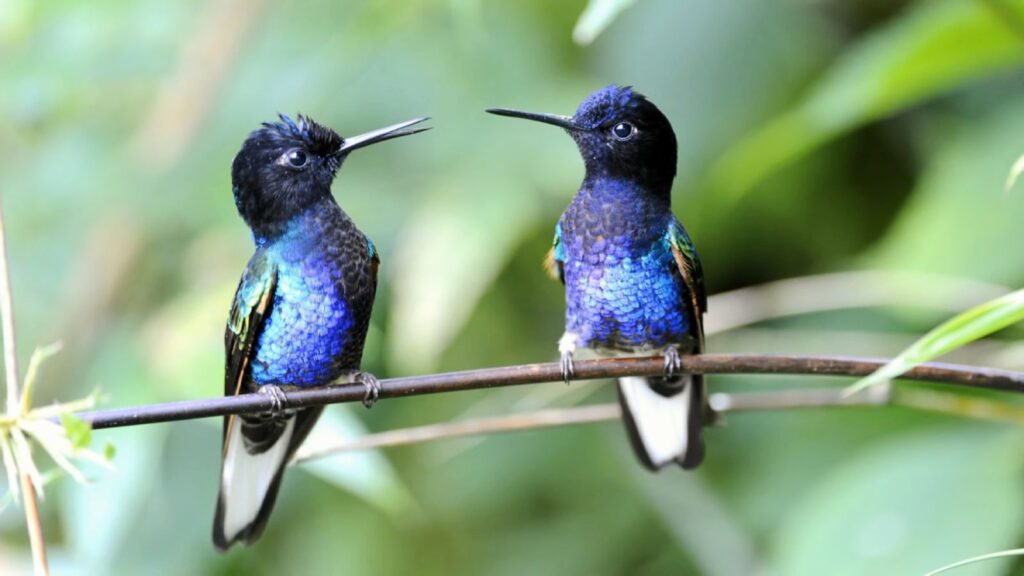Many people don’t realize that hummingbirds are only found naturally in the Americas, from Alaska to Chile, with the greatest variety located in tropical regions. You will not find hummingbirds in Africa, Australia, Europe, Asia, or Antarctica (although, we bet you could have predicted that they weren’t in Antarctica)!
These tiny, colorful birds have adapted to take advantage of flower nectar as their primary food source, although they also eat up to 2,000 insects in a day.
Their habitat preferences reflect the locations where they can find abundant flowers for food. Hummingbirds are most commonly found in areas that provide both flowers and trees or shrubs for nesting. They like meadows, gardens, orchards, woodland edges, backyards, and parks.
Because they are so small, they can live just about anywhere! Let’s learn about hummingbirds and the habitats they call home.
Understanding Hummingbirds: A Bird Difference
Hummingbirds have anatomical and behavioral adaptations that allow them to hover and feed on flower nectar. This means that they need plentiful blooms to survive. In places where the weather turns cold and the flowers die off, hummingbirds are only summertime visitors.
During the winter, they migrate south to warmer territories so that they can continue to find plenty of food.
Their wings can beat up to 80 times per second, enabling mid-air suspension as they insert their long bills into flowers. They can lap nectar with their tongues up to 18 times per second! Hummingbirds also have the highest metabolism of all birds, which is why they need to eat so frequently.
Unlike other birds that forage for nuts, seeds, insects, and other forms of food, hummingbirds primarily feed on sugar-rich nectar. They supplement their diet with small insects. Due to their unique adaptations, hummingbirds are found where there are lots of flowers available to provide calories. They prefer areas with a range of flowering plants that bloom at different times to ensure a constant nectar supply.
That’s why we always recommend that if you are going to grow a butterfly garden, you keep the blooming timeframe of the flowers in mind. It is best to plant flowers that will bloom consistently throughout the season.
Where Are Hummingbirds Generally Found?
You can find hummingbirds across most of America, at least during the summer. The only state they don’t visit at all is Hawaii. They are even found as far north as Alaska!
They are found along both the east and west coasts of the United States and Canada, throughout Central America, across the Andes Mountains, and in South America. They are also found in gardens and yards in all of these regions, making them popular with just about everyone who has the chance to see them.
Anyone can plant some flowers, either in a garden or a planter, and welcome hummingbirds into their world.
As you’re probably realizing, the common factor in all of their habitat preferences is the presence of adequate flowers, flowering shrubs, and trees.
For example, South American forests known for their high hummingbird diversity feature many flowering epiphytes and trees. Really, any habitat with a variety of tubular, nectar-rich flowers will attract hummingbirds.
Where Do Hummingbirds Nest?
Hummingbirds look for protected areas for their nests. They need to be able to camouflage their nests from predators, which include owls, blue jays, grackles, herons, tanagers, shrikes, and gulls.
Most hummingbird species build small, cup-shaped nests, which they hide among the leaves on branches of trees and shrubs. They cover the exterior of the nest with moss and lichen for extra camouflage.
Broad-leaved trees and shrubs offer quite a lot of protective cover, as opposed to conifers, which don’t really provide great nesting sites. Some species will nest in more open areas, such as rock ledges, low branches, or wires.
Hummingbirds line the interior of their nests with soft down feathers, which insulate the nest and protect the eggs and later the tiny hatchlings. Hummingbird eggs are only about the size of a navy bean!
One interesting behavior of hummingbirds is that many of them will reuse the same nest every year. Others will build a new nest each year, but as long as there is dense, low-growing vegetation that provides plenty of shade and protection, hummingbirds are going to be happy.
Hummingbirds in the United States

The United States is home to several hummingbird species, each of which has adapted to occupy their chosen habitats. The distribution of hummingbirds depends on food availability, suitable nesting sites, and climate.
Hummingbirds Across the States
Not long ago, Wild Bird Scoop created a useful guide showing when migrating hummingbirds arrive in and leave each state.
Here are some interesting facts about hummingbirds spread across the US:
- Hawaii is the only US state that has no hummingbirds at all.
- The first states to see hummingbirds arrive after their spring migration are Arizona, Florida, Louisiana, and Texas. In these states, hummingbirds usually arrive by the first week of March.
- The last arrivals are usually in North Dakota.
Species like the Ruby-throated Hummingbird and Rufous Hummingbird breed in the eastern and western United States respectively, then migrate to southern areas for the winter.
Anna’s, Black-chinned, and other western species populate along the Pacific Coast.
Broad-tailed Hummingbirds occupy mountain meadows, whereas Buff-bellied Hummingbirds primarily nest in south Texas. Overall, hummingbirds follow flower abundance and breeding territory needs rather than evenly dispersing across all states.
States With Hummingbirds Year-Round
Some hummingbird species can be found year-round in certain southern states. For example, Anna’s Hummingbirds overwinter along California’s coast, and Buff-bellied Hummingbirds reside in Texas for their whole life cycle.
Southern states like Arizona, Louisiana, Florida, and New Mexico may host Rufous, Black-chinned, Broad-tailed, Allen’s, Calliope, and other species during winter months when food is available. The milder climates in these states provide adequate flowers and nesting conditions so that hummingbirds can migrate here for the winter.
Hummingbirds and Migration: Winter Habitats
Most northern hummingbird species migrate in the winter, traveling south to habitats offering warmth and food.
Ruby-throated Hummingbirds are the most populous birds in North America, and in the winter, they move from their eastern US breeding range to southern U.S. states. Specifically, they are found in Mexico and along the Gulf Coast.
Rufous Hummingbirds nest farther north and migrate extensively, reaching Mexico and Central America.
The tiny Calliope Hummingbird has one of the longest migrations, flying between its breeding habitat in the northwestern United States all the way to Mexico for winter.
During migration and in their winter range, hummingbirds occupy habitats with flowering plants that provide nectar, including scrublands, pine and oak woodlands, gardens, and tropical forests. Clean and consistently filled feeders may also sustain hummingbirds in their winter habitats.
Feeders are also a great way to provide hummingbirds with lots of nutrition as they prepare for their migration, or even recover from it.
Hummingbirds at Night: Where Do They Go?
Hummingbirds have very high metabolisms and cannot go long without food. They stay busy all day long. How, then, do they make it through the night?
At night when flowers are closed, they enter a hibernation-like state called torpor that lowers their energy needs. Hummingbirds in torpor have been known to survive temperatures below freezing!
They pick protected nighttime roosts where they can sleep in relative safety. Many species prefer nesting in trees or shrubs, perching among dense branches and leaves. Some will hide in small tree cavities.
Some hummingbirds may sleep exposed along open wires and branches in more arid regions when vegetation is sparse. Even at night, they select locations that offer insulation and concealment from predators. Their night habits allow their survival in diverse habitats.
FAQ About Hummingbirds & Where They Live
Let’s take a look at some of the most commonly asked questions about hummingbirds and where they live.
Where Do Hummingbirds Sleep and Live?
Hummingbirds often sleep in trees and shrubs, choosing dense vegetation and cavities that provide protection from predators and elements.
Their small nests, lined with soft down feathers, allow insulation. At night they enter torpor, a deep sleep state where their metabolism and energy needs are reduced to help survive until morning. Hummingbirds in torpor have survived below-freezing temperatures.
What Do Hummingbirds Use for Shelter?
Hummingbirds primarily take shelter among dense branches and leaves. They construct tiny cup-shaped nests out of plant fibers, binding the materials with spider silk and occasionally bits of seed down. The nest’s exterior is then camouflaged with lichen or moss to match the tree or shrub. Other sheltered sites like large cavities in trees may be used at night.
What Do Hummingbirds Like To Live In?
Hummingbirds prefer habitats that offer tubular flowers providing nectar, flowering plants and shrubs for nest materials, broad-leaved trees to build nests on, and thick vegetation for shelter and insulation. Gardens, meadows, forests, and scrublands that meet these habitat needs are ideal environments for hummingbirds.
Where Do the Most Hummingbirds Live?
The highest diversity of hummingbird species is found in Central America, northern South America, and the Andean mountains where flowering plants are abundant. Some of the countries with the most hummingbirds include Ecuador, Colombia, Costa Rica, and Panama. The United States also hosts several breeding hummingbird species, especially along the Pacific Coast and Gulf Coast.
Ruby-throated Hummingbirds are the most common hummingbird in North America, and they can be found throughout the eastern half of the US.
Where Do Hummingbirds Live in America?
In North America, hummingbirds are found along the entire west coast, the Gulf Coast, throughout the Rocky Mountains, and across the eastern United States.
Some species have adapted to live anywhere flowers are present, while others have more specific habitat needs in meadows, forests, scrublands, or high elevations. The southwest United States is a particularly popular place for hummingbirds.
Even as some hummingbirds migrate away from the US southwest during the winter, others from more northerly territories travel to these southern states for the winter.
Where Are the Most Hummingbirds Located?
There is a dense concentration of hummingbird species that is found across Central America and northern parts of South America. Ecuador has over 130 species, the highest diversity in the world!
Other areas known for abundant hummingbirds are Colombia, Costa Rica, Panama, and southeastern Brazil. In the U.S., highly populated areas include Arizona, New Mexico, south Texas, and California.

